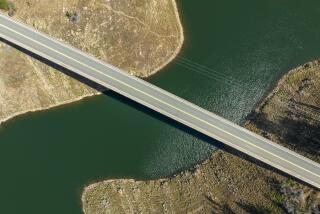Dry No More : Santa Barbara Lifts Lawn Watering Ban, but Not Everyone Is Cheering
- Share via
SANTA BARBARA — City officials here lifted a 14-month-old ban on lawn watering Tuesday, scant weeks after March rains eased the drought--but three days too late for homeowner John Golin.
The Santa Barbara City Council decided that rain-swollen streams, an infusion of state water and plans to build a desalination plant would lessen drought conditions enough to allow residents to water their lawns again, between 6 p.m. and 8 a.m.
The move gladdened many homeowners who had been irrigating thirsty turf with bathwater, spray-painting their browning lawns green or abandoning them to the killing sun.
But others, including Golin, a retired gardener, questioned the wisdom of such a luxury when Santa Barbara’s water supplies still are 20% below normal.
“It’s a joke, if you ask me. We’re not out of this problem. You might as well save the water,” said Golin, resting a weathered hand on the spade he was using to tend the small garden that now covers half his front yard.
He pointed to the sickly yellow thatch covering the other half.
“I just killed my grass,” said Golin. “I sprayed it with weed killer three days ago. It just wasn’t worth the effort anymore.”
Golin and his wife, Louise, have lived on Voluntario Street for nearly 40 years and have weathered four droughts. But none has been as serious as this one, which requires them to use bathwater and sink runoff to keep roses and fruit trees alive and water bills down.
The lawn will stay dead despite the council vote, said Golin. Then a smile stole over his face. He added, “Maybe we’ll take an extra bath.”
City officials said they are not encouraging residents to water their grass, merely permitting the practice after spring rains greened the dry, brown patches in front of many homes.
“We’re not asking people to water their lawns,” City Councilwoman Harriet Miller said during the meeting at City Hall. “We’re just giving them the flexibility, and we’re asking them to consider the semi-arid area in which we live.”
“Most people have been pretty supportive” of the ban, Public Works Director David Johnson said. “But there’ve been a few comments made that people should have had a choice” on how to use their water, he said.
The ban went into effect in February, 1990. In lifting the prohibition, council members cited higher levels of state-controlled water and the planned ocean water desalination plant they hope will be operating by next spring.
In six weeks, the council plans to adjust water rates to pay for these sources, raising costs for low-volume users such as single-family homes, while lowering them slightly for high-volume users, Johnson said.
“It’s going to cost more,” said homeowner Chris Miao.
She said she will put off replacing her dead lawn with new sod, despite the end of the watering ban.
“I’m ambivalent about it,” she said. “I’d like to see everything look nicer, but I’m not sure the drought is over. There isn’t a whole lot of water. I’d rather be conservative and wait until next year.”
At the Olive Gardens apartment complex for the elderly, lush, new grass has poked up through the remains of the old lawn, which had been painted with green vegetable dye last winter.
“It was like a deep, emerald green,” assistant administrator Anna Pacheco said of the fake foliage. “It looked really nice when we had it painted, but then people walked on it and it weathered and started to look ugly.”
Now, even with the ban lifted, the grass there probably won’t get much water, Pacheco said. “I don’t think everybody waters that much when they know it’s a Stage 3 drought,” she said.
The watering ban has killed lawns throughout Santa Barbara, even in the high-priced neighborhood along Alston Road known as the Riviera, where some residents bought irrigation water from truck services using recycled drain water.
Restaurant owner Bruce Reichard said he looks forward again to turning sprinklers on the browned three-fourths of the lawn surrounding his Spanish-revival house and pool house.
He has kept one-fourth of the lawn alive with tap water, but had to replace much of the grass with purple ice plant and other drought-tolerant foliage, he said. “The landscaping is what really kinda suffered,” he said.
More to Read
Sign up for Essential California
The most important California stories and recommendations in your inbox every morning.
You may occasionally receive promotional content from the Los Angeles Times.













